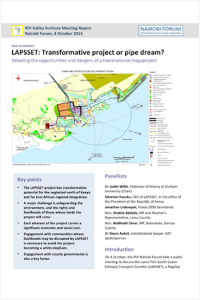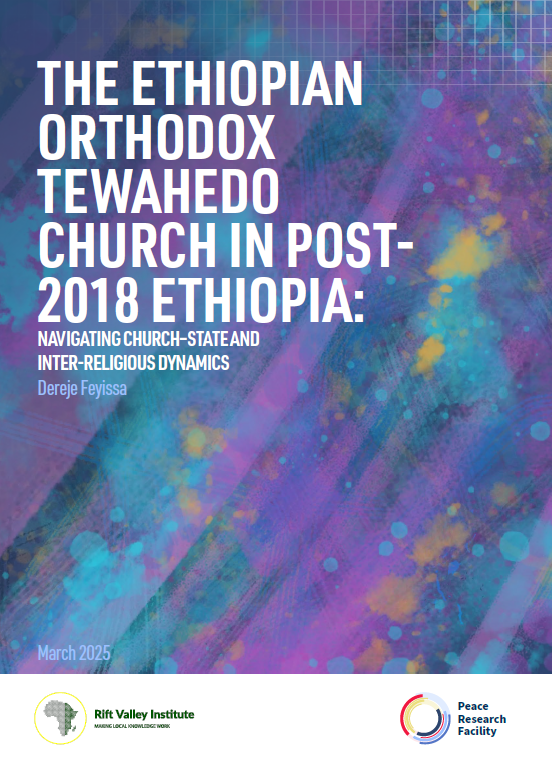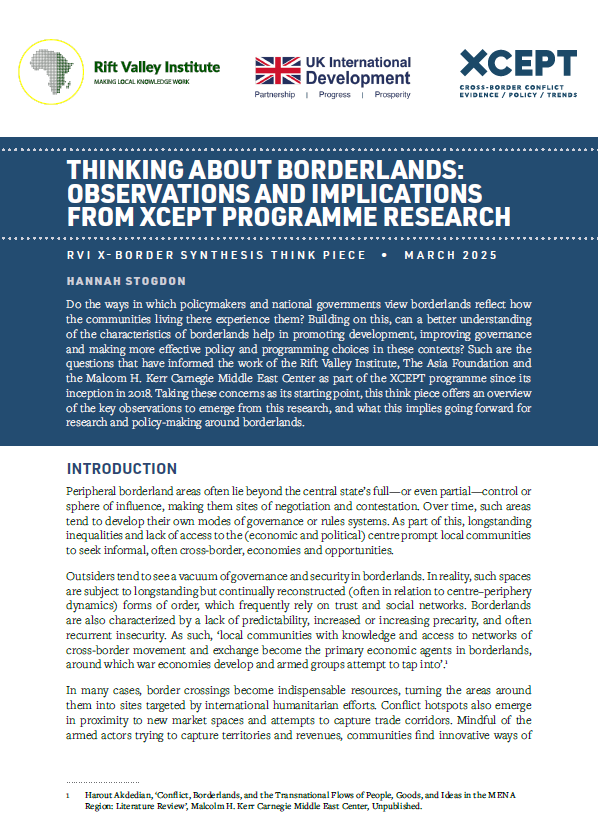Key points
-
The LAPSSET project has transformative potential for the neglected north of Kenya and for East African regional integration.
-
A major challenge is safeguarding the environment, and the rights and livelihoods of those whose lands the project will cross.
-
Each element of the project carries a significant economic and social cost.
-
Engagement with communities whose livelihoods may be disrupted by LAPSSET is necessary to avoid the project becoming a white elephant.
-
Engagement with county governments is also a key factor.
Panellists
Dr Justin Willis, Professor of history at Durham University (Chair)
Silvester Kasuku, CEO of LAPSSET, in the office of the President of the Republic of Kenya
Jonathan Lodompui, Vision 2030 Secretariat
Hon. Shakila Abdalla, MP and Women’s Representative, Lamu County
Hon. Abdikadir Omar, MP, Balambala, Garissa County
Dr Ekuru Aukot, constitutional lawyer, G47 spokesperson
Introduction
On 4 October, the RVI Nairobi Forum held a public meeting to discuss the Lamu Port-South Sudan Ethiopia Transport Corridor (LAPSSET), a flagship project of Kenya’s government-sponsored Vision 2030. A panel composed of representatives of government, parliament and civil society discussed the effects that this major project will have on communities in northern Kenya and neighbouring countries. The meeting attracted participation from donors and researchers, representatives of government and the communities affected by the project.
The plan for the corridor combines many elements: the development of a new port at Lamu; an oil pipeline from Lamu to South Sudan; and road and railway links to the west and possibly to southern Ethiopia. There are also plans for a new international airport and so-called ‘resort cities’ along the line of the railway. The completion of any one of these elements would have a significant impact; in combination they could transform the region.
Panellists at the Forum meeting, who included two MPs from areas affected by the corridor, discussed these issues with vigour. All present agreed that the project offered prospects of betterment for the people of the region; but those from the area warned that it had started on the wrong terms and that it could not succeed without a significantly increased level of local participation.
John Ryle, Director of the Rift Valley Institute welcomed panelists and attendees to this, the 32nd meeting of the Nairobi Forum. Nuur Sheekh, RVI Nairobi Forum Programme Coordinator, introduced the chair of the panel, Dr Justin Willis of Durham University, an RVI trustee and former director of the British Institute in Eastern Africa (BIEA).
Historical parallels
Justin Willis began the panel discussion by drawing historical parallels between the LAPSSET project and the construction of the Kenya-Uganda Railway a century ago. Described at the time by British parliamentarians as a ‘gigantic folly’, a ‘worthless speculation’, and ‘a foolish and wild venture’, the ‘Lunatic Express’, as the railway was referred to by skeptics, was ultimately built, but at a considerable cost. There were no consultations with communities, Dr Willis pointed out, no environmental impact assessments, and little concern for the health and safety of the work force or those whose lands the railway traversed.
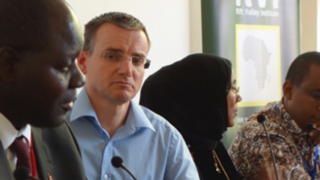
The building of the Railway was visionary, but it was also driven by political ambition and personal greed, with many speculators and contractors making a profit at the expense of the public in a frontier region where scrutiny of public contracts was lax or non-existent. It cost double the original budget. And yet, Dr Willis said ‘I do not think that many would now prefer it had not been built, nor that the populace of Mombasa would wish the port away.’
The world is different now, he noted. Kenyans can vote and have rights enshrined in law. The Kenya of Vision 2030, in which LAPSSET is embedded, is proclaimed as a country ‘where rights and freedoms are protected, and we are ruled by democracy.’ LAPSSET, however, like the Kenya-Uganda Railway, faces a multiplicity of challenges, including technical, financial and security issues. ‘The real challenge’, Dr Willis said, ‘is how to realize LAPSSET’s transformative potential in terms of regional integration, and the creation of wealth and human opportunity, while safeguarding the environment and the rights and livelihoods of those whose lands the project will cross.’ The purpose of the panel, he concluded was to consider all these challenges and encourage discussion about how they may be met.
LAPSSET and the government
Jonathan Lodompui explained that LAPSSET is one of 124 flagship projects under Kenya’s Vision 2030, the national long-term development blue-print, which is aimed at transforming the country into a mid-level economy with 10% annual growth. Through its components—the Lamu Port, regional highways and a railway line, oil pipelines, refineries and resort cities in Lamu, Isiolo and Lake Turkana–LAPSSET is expected to generate at least 3% of Kenya’s Gross Domestic Product. The 200m-wide LAPSSET corridor will link Lamu on Kenya’s coast to Juba, South Sudan, 1,700 km away, with expectations that this corridor will form part of a future equatorial ‘land bridge’ linking eastern and western Africa via Juba, and Bangui in the Central African Republic, to Douala, Cameroon. There are also road links planned to Addis Ababa via Moyale in Kenya. The Vision 2030 secretariat will implement LAPSSET in phases. Challenges facing LAPSSET include concerns over land rights, population displacement and pastoral migration routes.
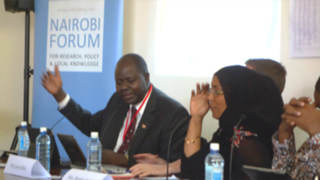
Silvester Kasuku, CEO of LAPSSET, highlighted some of the project’s expected outcomes including seamless connectivity, new jobs and a transformative infrastructure that will open up the northern frontier. Over 60% of northern Kenya, he noted, remains unexploited, despite the massive water and hydrocarbon resources there. The LAPSSET project was launched on 2 March 2012 by the governments of Kenya, Ethiopia and South Sudan to facilitate regional trade. Uganda also recently joined the project. Explaining the LAPSSET authority’s vision, Kasuku said: ‘We believe that the next giant to wake up… is the African continent. We do expect that the countries that will take the early lead with regards to putting in place the required infrastructure, the required conditions for investment, are the ones that will benefit greatly… In this case, Kenya is taking the leading role in the waking up of the last and biggest giant.’
Responding to Kasuku’s presentation, one participant expressed concern that LAPSSET could end up being a ‘white elephant’ project. Another sought clarification on the level of confidence that the LAPSSET authority has in Ethiopia’s and South Sudan’s commitment to the project. Concern was also raised over the level of community engagement in Kenya. In response, Silvester Kasuku said that white elephant projects were the work of past regimes. He reiterated the Kenyan government’s commitment. He added that LAPSSET is negotiating with the governments of South Sudan and Uganda with regard to the oil pipeline. He noted that the road linking Kenya to Ethiopia via Moyale is under construction and that Ethiopia was similarly constructing a road on its side of the border. As for community engagement, Kasuku said that the community steering committees in Lamu and elsewhere will receive government funding to enable them to conduct their functions.
Community concerns
Shakila Abdalla noted that there had been inadequate information sharing when it came to LAPSSET and she suggested that a steering committee, which would serve as a link between the community and LAPSSET, be set up to facilitate dialogue. She expressed concern that families displaced by the construction of the Lamu Port are yet to be compensated. She added that there is a need for the Kenyan government to take into account the potential cumulative effects of LAPSSET on local communities instead of only focusing on those who will be directly affected.
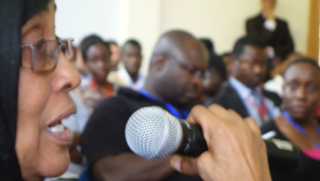
She highlighted the situation of marginalized communities, such as the Boni in Lamu, who she said should be assisted to safeguard their land. With a substantial anticipated population influx, she argued, Lamu County needs an infrastructure development plan. It has an estimated population of about 102,000 residents, but the number could more than double by 2017. She proposed that the Lamu County should be allocated at least 30% of revenue from the Lamu Port once the latter is completed.
In response to Hon. Shakila’s concerns, Silvester Kasuku said that the environmental issues have been taken into consideration. He added that there are plans to create a fishing berth in Lamu to support the local fishing industry. For capacity development, the government has allocated money, towards scholarships for local students. Jonathan Lodumpui explained that the government is sourcing funds to compensate those displaced by the Lamu port construction. He noted that communal land ownership in Lamu is complicating the compensation process due to a lack of individual land title deeds.
Ekuru Aukot asked how much the Kenyan government is contributing to LAPSSET. Silvester Kasuku explained that the government is funding 25%. He said that the first three of 41 berths at the Lamu Port are expected to be completed by 2017-2018, when Kenya is expected to start producing oil commercially.
Abdikadir Omar expressed his constituents’ concerns that the LAPSSET corridor may adversely impact on their pastoral livelihoods. There is a need, he said, for community consultations in order to pre-empt conflict, addressing the problems from a host community point of view. These issues should be addressed ‘before a camel and a bulldozer are facing each other.’
Ekuru Aukot noted that central to the LAPSSET project is the issue of land management. He sought to rectify the misconception that pastoral lands are free of ownership, noting that they are communally owned and this should shape the approach over LAPSSET. He called LAPSSET to be planned to as to avoid a Niger Delta situation. ‘You cannot ignore us for 50 years then Turkana becomes the lingua franca after the discovery of oil,’ said Aukot. ‘How’, he added, ‘can the [LAPSSET] project be designed in advance to avoid problems?’
Shakila Abdalla added that there is a need to address community concerns first before setting up physical structures. Another discussant sought to know if investments in education are being made along the LAPSSET corridor and what some of the benefits of LAPSSET have been so far.
In response, Silvester Kasuku noted that over 70% of Kenya is lacking in capacity building institutions and noted that LAPSSET encompasses the provision of infrastructure and services in an integrated way. The detailed planning for the same, he said, is ongoing. He added: ‘We will not want to engage in haphazard development in northern Kenya. Local communities will be involved in this planning process.’
 Several questions were raised by other participants. Why, for instance, had community consultations not taken place before the project started? The project should have anticipated loss of property rights, livelihoods, and resultant displacement, and put measures in place to compensate affected communities before the start of the project, rather than dealing with this after the project has already started. Had any cost benefit analysis been done to see whether the project is viable, given that massive infrastructural projects have stalled in the past?
Several questions were raised by other participants. Why, for instance, had community consultations not taken place before the project started? The project should have anticipated loss of property rights, livelihoods, and resultant displacement, and put measures in place to compensate affected communities before the start of the project, rather than dealing with this after the project has already started. Had any cost benefit analysis been done to see whether the project is viable, given that massive infrastructural projects have stalled in the past?
An attendee at the meeting noted that failure to take into account community perspectives could deny LAPSSET funding. Another sought to know how much money has been set aside to compensate those displaced by the Lamu Port construction. There was also concern that the planned Isiolo resort city will affect dry-season pastoral grazing areas, exacerbating resource-based conflict. In response, Jonathan Lodompui said that the 144 families affected by the Lamu Port construction will be compensated at a market price of 1.5 million shillings per acre. He clarified that the land allocated to the Isiolo resort city is government owned and added that the Isiolo County government has been tasked to seek amicable solutions. Reiterating LAPSSET’s viability, he said: ‘We shall continue to re-engage [with the communities] until these worries are washed away.’
Re-engaging with stakeholders
In the final discussions panellists proposed the way forward for LAPSSET project. Shakila Abdalla suggested that that there is a need to go back to the drawing board in order to pre-empt problems and to involve communities that may be affected by the project. Abdikadir Omar emphasized the need to devolve LAPSSET decisions. ‘Is it [LAPSSET] for the people or has it been decided for the people?’ he asked.
Reiterating Abdikadir Omar’s view, Ekuru Aukot recommended that LAPSSET should be anchored in devolution. ‘Why don’t we begin by devolving it to harness legitimacy to take the project forward?’ he asked. Aukot also called for prioritization to address the urgent issues currently affecting marginalized communities. ‘Many of us from marginalized areas need Vision 2030 now. We need to discuss insecurity.’ He added that he hoped that the LAPSSET project, ‘will bridge the gap between the two Kenyas.’
Jonathan Lodompui offered reassurance that there would be continued re-engagement with communities to allay their fears over the LAPSSET project through dialogue with local leaders. Effectiveness will be increased now that the county system of governance is in place. ‘Strategic planning is a step-by-step process and nothing really meaningful will happen unless people agree, thus the need for re-engagement,’ said Lodompui.

